



Similar to washing dishes, dirt shifts much
better from paintwork if it's subjected to a thorough soaking first. Not
only will a good drench begin to remove loose dirt but also help soften stubborn
grime. This is where the use of a hosepipe is extremely beneficial -- with
the nozzle set to something a bit powerful you can jet wash the car
to a certain degree. Even better, if you have access to a pressure washer then
consider using it (but be careful about removing any loose paint work!)
Starting with the roof thoroughly soak the
bodywork and work your way down the car, as if to wash the dirt off from top
to bottom. Don't believe you'll clean the car this way because
you won't. This is simply the first step to a perfectly clean car.
You may also need to re-soak from time-to-time.
NOTE: Ignoring this step will
eventually leave scratched bodywork as pulling a sponge over dry, stuck-on dirt
only serves to drag grit across your otherwise shiny paintwork.

The use
of an appropriate
car shampoo is essential. Under no circumstances should you use domestic
detergents like washing-up liquid or dishwasher soaps which will eat away at your car's paintwork. Turtle Wax Extreme Wash & Wax
is just right for the task and it doesn't generate a slimy solution like other
shampoos I've used. Any residue left behind will easily wipe away
with
a chamois later too (see below).
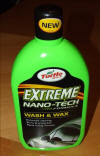
Fill a bucket or two with warm water. If
you only have one bucket then be prepared to re-fill a couple of times -- don't
try to make one bucket last the entire car wash. Try not to use scalding
hot water either -- it's not good for your skin or your car's bodywork. Add the prescribed amount
of shampoo to each bucket. To avoid a bubble-bath, poor in the shampoo when the
bucket is already full and mix gently with your hand.

For the perfect wash use a clean sponge and
start with the roof, working your way down to about half-way (i.e.
roof,
glass, bonnet, headlamps, upper-door panels, engine lid, boot, and spoiler).
Remember to press gently with the sponge -- you're trying to remove the dirt,
not drive it into your paintwork causing damage. Also don't forget to
regularly dip the sponge into your bucket of soapy water -- to remove the dirt
and muck it's collected.
For any stubborn dirt you may need to re-soak it with clean
water or your shampoo solution. Apply a little pressure if necessary but
do be careful.
Once washed, rinse thoroughly with plenty of clean water (this is where a
hose pipe really does make life easy).
Next use an older sponge to clean the lower
half of the bodywork (i.e. front lip and bumper, rear bumper,
lower door trim, and exhaust tips) and again rinse thoroughly. Whilst rinsing, check for any patches you may have missed
or any stubborn dirt that you might need to go back to.
To finish off, use a very old sponge purely
for the wheels and tyres. For the best results, pre-treat alloys to get
rid of baked-on brake dust and other stubborn road grime. See
here for tips on what to use. Once
clean, rinse as before.
NOTE: The use of different sponges is
key. This helps prevent cross-contamination of dirt and paintwork scratching which could
result.

A chamois leather
(pronounced "shamee") is a long established
and natural product which is extremely absorbent. With the car rinsed -
and probably still covered in water - the
use of a chamois will dry the bodywork, remove water marks, and even add a
little
shine (as most shampoos contain a small amount of wax).
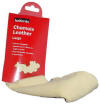
Before use, the
chamois needs to soak in clean water so that it can turn supple -- it's best to
do this a good while before you need it. To use, squeeze so that it's only
slightly damp and wipe over the bodywork in wide, sweeping motions so that it can absorb the standing water.
When the chamois is wet, squeeze and repeat until all the water has been
removed. Periodically rinse the chamois in clean water to remove any dirt that might have been picked up. Avoid the wheels and
exhaust tips else you'll collect grit which will then scratch your paintwork.
NOTE: To care for your
chamois, after use soak in clean, soapy water then hang to dry. Soap helps
to keep the chamois soft and prevents cracking when it dries.

With paintwork clean and dry you can easily
asses what condition it's in. Scratches, blemishes, and oxidation
can
render paintwork scruffy and tired-looking -- irrespective of having just been
cleaned. Where a thorough clean and polish aren't enough, a number of products
exist on the market which will attempt to
renovate (or cut) paintwork thus removing stubborn grime, oxidation, tar spots,
and fine scratches. However, they must be used with care.
NOTE: Paintwork renovation products should only be used as and when required
and not as a frequent step when cleaning a car.
The
term "t-cut" is generally associated with any solution which cuts and restores
paintwork but T-Cut itself is also an actual product which has been in
circulation for many years. Originally a superb cutting solution, in
recent years the formula has disappointingly changed and Car Plan's mainstream
restorer is characteristic of a standard polishing wax now, although its packaging is
labelled as T-Cut Original (see below).
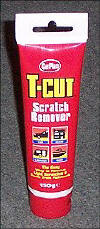
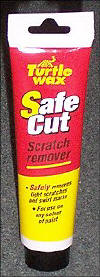
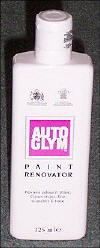
Given a sister product, the original T-Cut solution is now
effectively
marketed as T-Cut Rapid Scratch Remover and is in the same category as Turtle Wax Safe Cut Scratch Remover
and Auto Glym Paint Renovator. On
clean paintwork the solutions are used
with either a dry or damp cloth and applied to the offending areas as necessary. After
drying to a haze the residue is
to be wiped away followed by the essential addition of a coating of your
preferred wax or polishing wax (to act as a protective barrier for your nearly new paintwork).
Auto Glym Paint Renovator is
the best of the bunch in my opinion because the T-Cut and Safe Cut products simply
don't renovate the paintwork quite so well.

With washing and any necessary paintwork
maintenance complete, it's time to add a protective coating of wax. Thing
is, sometimes the application of polishing waxes (see below) can be
quite time consuming and a little messy. For a clean, quick, and
convenient protective
coating, consider Turtle Wax Extreme Speed Wax
-- another excellent product in the Extreme range.
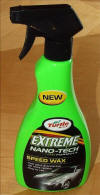
Speed Wax
can be used immediately after a
chamois or to compliment a dose of polishing wax as an additional protective
barrier. To apply, spray the
clear solution onto paintwork and wipe over a small area. Before it
completely dries, wipe away using another, clean cloth. What remains is an
excellent shine and protective coating. Simple, quick, clean, and
easy.

Even with frequent washing paintwork can still
become dull-looking due to weathering and oxidation. To bring back that
sparkle and help keep bodywork in good order, consider the use of a good quality
polishing wax -- not only will it remove most traces of stubborn grime and leave a
superb shine but also add a protective coating. How often you apply polish
is up to you, but I'd recommend at least twice a year, especially before winter.
Most of today's polishing waxes are variations on a
theme -- liquids applied with a clean cloth, some added elbow grease, left to
dry to a haze, and finally wiped away and buffed to leave an impressive shine.
Sometimes you get some powdery remains which just need wiping away. Most
polishes are neutral in colour but some are literally colour-matched and
designed to inject an element of colour restoration back into the paintwork.
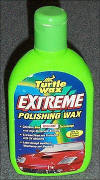
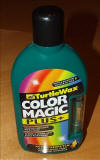
Turtle Wax
Extreme Polishing Wax and Turtle Wax Color Magic Plus+ are my
personal favourites. The former is neutral in colour and the latter is
colour-matched. Both give a rich and long-lasting shine with the end
results being superb. They both shift any remaining grime with ease and
leave no greasy residue, so both highly recommended. If you're wondering
why the Color Magic above is green, this is what I use on my Subaru.
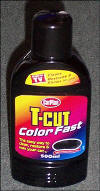
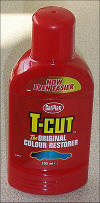
In contrast,
Car Plan T-Cut
Color Fast is a coloured polish and although the end results are pleasing,
it can
take a lot of buffing to achieve that deep, dark shine and remove all traces of
greasiness. Also, after the next car wash my black paintwork has always appeared
dark
grey as opposed to black which is odd. Car
Plan T-Cut Original Colour Restorer is a major disappointment -- so much
in fact that I simply threw the bottle away after just two uses.
Based on the original T-Cut solution from years gone by it can still remove
surface grime and oxidation but only after two or more attempts on the same
patch of paintwork. It's also very stubborn to remove and leaves paintwork greasy and streaky
looking. Awful product.
NOTE: Whatever the polish, definitely
consider the use of gloves when applying it.

Weathering can
have a drastic effect on black trim, turning it dark grey and scruffy-looking. Thankfully, Car Plan Black Trim Wax is designed specifically for
treating black bumpers, mouldings, grills, mirrors, spoilers, rubber, and
plastic trim sections (although not all these are applicable to an MR2).
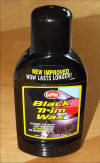
Where it can be used on my MR2 the results
are superb, transforming light grey and tired trim into a new-looking black
variety. Wearing gloves to prevent staining of fingers, the black cream is
massaged into the desired areas and allowed to dry, then using a separate cloth any residue is removed and an element of shine can be obtained given some
buffing if so
desired.

Stainless steel items like
exhaust tips, polished back boxes, and door sills will benefit immensely from a
little care and attention. Unfortunately there's not much metalwork to be
found on an MR2 but what there is will spoil the overall
effect if it's neglected.
Just like everything else
on the car, stainless steel should be given a clean first so that any polishes
used for the main event don't have to cut through layers of grime. Don't
expect it to necessarily come up clean though as oxidation will more than
likely leave metalwork discoloured. Certainly for exhaust bits, use a very old sponge
too.
To date I've only used one brand of metal
polish simply because it works.
Auto Glym Metal
Polish is a rich cream which offers superb additional cleaning properties as
well as creating a shine that you can see your reflection in. Apply with a
clean, dry cloth and with some pressure you'll see tarnish and dirt lift off.
With another clean cloth remove the remaining residue and buff to a brilliant
shine.
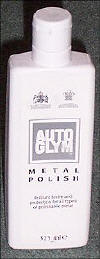

The bane of all cleaning. No sooner is it
clean and it's dirty again. Unfortunately when it
comes to glass it's just nature of the beast I'm afraid... but when it's
sparkling clean it really does finish a car off quite nicely!
Domestic glass cleaners like Mr Muscle Window
& Glass Cleaner will do an excellent job of removing any remaining grime
following a car wash, but if the glass is persistently grubby with dried on
insects or grease then you might want to consider using a cutting solution
first. Such products (like Halfords
Intensive Glass Cutter) should remove all traces of stubborn grime as well
as rain
repelling and anti-fogging solutions.
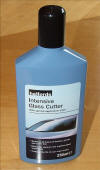
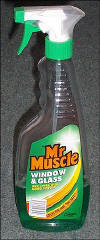
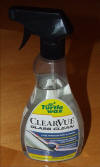
I never thought I'd find a Turtle Wax product
I didn't like but Turtle Wax ClearVue Glass Clean doesn't work for me.
After a number of uses, with an array of cloths, greasy streaks always get left
behind so I won't be using it again.
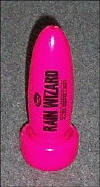
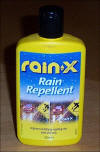
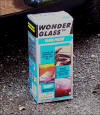
With
clean glass it's worth considering a rain repellent. Such repellents
reduce surface tension so that rain water beads-off -- vastly improving
visibility when the car's in motion and it's raining (especially when it's
dark). As an
avid fan of Rain Wizard, when it ceased to be available I was forced to
use its more well-known rival Rain-X Rain
Repellent, or simply Rain-X as it's more commonly known. It's
extremely easy to apply using a wipe
on, wipe off method and in addition to superb repelling properties an
excellent shine is to be had. It can also be used on lens units and mirrors.
One
to avoid is Wonder Glass which is designed to be used inside
and out. Although it's extremely easy to
apply (using a sponge) the end results are
annoying. The solution dries to a powder, which isn't too bad but it sticks to and colours small chips and scratches
in the surface of the glass.
The downside of this product is that it makes defects
stand out and with its short-lived repellent properties, just don't bother with
this one.

